Enhanced UV Photoresponsivity of ZnO Nanorods Decorated with Ag2S/ZnS Nanoparticles by Successive Ionic Layer Adsorption and Reaction Method
Abstract
1. Introduction
2. Materials and Methods
3. Results and Discussion
4. Conclusions
Author Contributions
Funding
Data Availability Statement
Conflicts of Interest
References
- Gedamu, D.; Paulowicz, I.; Kaps, S.; Lupan, O.; Wille, S.; Haidarschin, G.; Mishra, Y.K.; Adelung, R. Rapid fabrication technique for interpenetrated ZnO nanotetrapod networks for fast UV sensors. Adv. Mater. 2014, 26, 1541–1550. [Google Scholar] [CrossRef]
- Guo, D.; Wu, Z.; Li, P.; An, Y.; Liu, H.; Guo, X.; Yan, H.; Wang, G.; Sun, C.; Li, L.; et al. Fabrication of β-Ga2O3 thin films and solar-blind photodetectors by laser MBE technology. Opt. Mater. Express 2014, 4, 1067–1076. [Google Scholar] [CrossRef]
- Li, X.; Rui, M.; Song, J.; Shen, Z.; Zeng, H. Carbon and graphene quantum dots for optoelectronic and energy devices: A review. Adv. Funct. Mater. 2015, 25, 4929–4947. [Google Scholar] [CrossRef]
- Ning, Y.; Zhang, Z.; Teng, F.; Fang, X. Novel transparent and self-powered UV photodetector based on crossed ZnO nanofiber array homojunction. Small 2018, 14, e1703754. [Google Scholar] [CrossRef]
- Lu, H.; Dong, H.; Jiao, S.; Nie, Y.; Wang, X.; Wang, D.; Gao, S.; Wang, J.; Su, S. The influence of annealing temperature on structure, morphology and optical properties of (InxGa1-x)2O3 films. ECS J. Solid State Sci. Technol. 2019, 8, Q3171–Q3175. [Google Scholar] [CrossRef]
- Lu, H.; Jiao, S.; Nie, Y.; Liu, S.; Gao, S.; Wang, D.; Wang, J.; Li, L.; Wang, X. Defect photoluminescence and structure properties of undoping (InxGa1-x)2O3 films and their dependence on sputtering pressure. J. Alloys Compd. 2020, 823, 153903. [Google Scholar] [CrossRef]
- Fang, X.; Bando, Y.; Gautam, U.K.; Zhai, T.; Zeng, H.; Xu, X.; Liao, M.; Golberg, D. ZnO and ZnS Nanostructures: Ultraviolet-light emitters, lasers, and sensors. Crit. Rev. Solid State Mater. Sci. 2009, 34, 190–223. [Google Scholar] [CrossRef]
- Kong, W.Y.; Wu, G.A.; Wang, K.Y.; Zhang, T.F.; Zou, Y.F.; Wang, D.D.; Luo, L.B. Graphene-beta-Ga2O3 heterojunction for highly sensitive deep UV photodetector application. Adv. Mater. 2016, 28, 10725–10731. [Google Scholar] [CrossRef] [PubMed]
- Nie, Y.; Jiao, S.; Meng, F.; Lu, H.; Wang, D.; Li, L.; Gao, S.; Wang, J.; Wang, X. Growth and properties analysis of AlxGa2-xO3 thin film by radio frequency magnetron sputtering using Al/Ga2O3 target. J. Alloys Compd. 2019, 798, 568–575. [Google Scholar] [CrossRef]
- Lopez-Sanchez, O.; Lembke, D.; Kayci, M.; Radenovic, A.; Kis, A. Ultrasensitive photodetectors based on monolayer MoS2. Nat. Nanotechnol. 2013, 8, 497–501. [Google Scholar] [CrossRef]
- Mastro, M.A.; Kuramata, A.; Calkins, J.; Kim, J.; Ren, F.; Pearton, S.J. Perspective—Opportunities and future directions for Ga2O3. ECS J. Solid State Sci. Technol. 2017, 6, P356–P359. [Google Scholar] [CrossRef]
- Sang, L.; Liao, M.; Sumiya, M. A comprehensive review of semiconductor ultraviolet photodetectors: From thin film to one-dimensional nanostructures. Sensors 2013, 13, 10482–10518. [Google Scholar] [CrossRef]
- Gogurla, N.; Sinha, A.K.; Santra, S.; Manna, S.; Ray, S.K. Multifunctional Au-ZnO plasmonic nanostructures for enhanced UV photodetector and room temperature NO sensing devices. Sci. Rep. 2014, 4, 6483. [Google Scholar] [CrossRef]
- Guo, F.; Yang, B.; Yuan, Y.; Xiao, Z.; Dong, Q.; Bi, Y.; Huang, J. A nanocomposite ultraviolet photodetector based on interfacial trap-controlled charge injection. Nat. Nanotechnol. 2012, 7, 798–802. [Google Scholar] [CrossRef] [PubMed]
- Hu, L.; Yan, J.; Liao, M.; Xiang, H.; Gong, X.; Zhang, L.; Fang, X. An optimized ultraviolet-A light photodetector with wide-range photoresponse based on ZnS/ZnO biaxial nanobelt. Adv. Mater. 2012, 24, 2305–2309. [Google Scholar] [CrossRef]
- Jeong, I.S.; Kim, J.H.; Im, S. Ultraviolet-enhanced photodiode employing n-ZnO/p-Si structure. Appl. Phys. Lett. 2003, 83, 2946–2948. [Google Scholar] [CrossRef]
- Peng, L.; Hu, L.; Fang, X. Energy harvesting for nanostructured self-powered photodetectors. Adv. Funct. Mater. 2014, 24, 2591–2610. [Google Scholar] [CrossRef]
- Rai, S.C.; Wang, K.; Ding, Y.; Marmon, J.K.; Bhatt, M.; Zhang, Y.; Zhou, W.; Wang, Z.L. Piezo-phototronic effect enhanced UV/visible photodetector based on fully wide band gap type-II ZnO/ZnS core/shell nanowire array. ACS Nano 2015, 9, 6419–6427. [Google Scholar] [CrossRef]
- Víctor-Román, S.; García-Bordejé, E.; Hernández-Ferrer, J.; González-Domínguez, J.M.; Ansón-Casaos, A.; Silva, A.M.T.; Maser, W.K.; Benito, A.M. Controlling the surface chemistry of graphene oxide: Key towards efficient ZnO-GO photocatalysts. Catal. Today 2020, 357, 350–360. [Google Scholar] [CrossRef]
- Tian, W.; Zhang, C.; Zhai, T.; Li, S.L.; Wang, X.; Liu, J.; Jie, X.; Liu, D.; Liao, M.; Koide, Y.; et al. Flexible ultraviolet photodetectors with broad photoresponse based on branched ZnS-ZnO heterostructure nanofilms. Adv. Mater. 2014, 26, 3088–3093. [Google Scholar] [CrossRef]
- Zhang, Q.; Jie, J.; Diao, S.; Shao, Z.; Zhang, Q.; Wang, L.; Deng, W.; Hu, W.; Xia, H.; Yuan, X.; et al. Solution-processed graphene quantum dot deep-UV photodetectors. ACS Nano 2015, 9, 1561–1570. [Google Scholar] [CrossRef] [PubMed]
- Zhao, B.; Wang, F.; Chen, H.; Wang, Y.; Jiang, M.; Fang, X.; Zhao, D. Solar-blind avalanche photodetector based on single ZnO-Ga(2)O(3) core-shell microwire. Nano Lett. 2015, 15, 3988–3993. [Google Scholar] [CrossRef] [PubMed]
- Zhou, J.; Gu, Y.; Hu, Y.; Mai, W.; Yeh, P.H.; Bao, G.; Sood, A.K.; Polla, D.L.; Wang, Z.L. Gigantic enhancement in response and reset time of ZnO UV nanosensor by utilizing Schottky contact and surface functionalization. Appl. Phys. Lett. 2009, 94, 191103. [Google Scholar] [CrossRef]
- Hsu, M.-H.; Chang, C.-J.; Weng, H.-T. Efficient H2 production using Ag2S-coupled ZnO@ZnS core-shell nanorods decorated metal wire mesh as an immobilized hierarchical photocatalyst. ACS Sustain. Chem. Eng. 2016, 4, 1381–1391. [Google Scholar] [CrossRef]
- Khanchandani, S.; Srivastava, P.K.; Kumar, S.; Ghosh, S.; Ganguli, A.K. Band gap engineering of ZnO using core/shell morphology with environmentally benign Ag2S sensitizer for efficient light harvesting and enhanced visible-light photocatalysis. Inorg. Chem. 2014, 53, 8902–8912. [Google Scholar] [CrossRef]
- Liu, S.; Wang, X.; Zhao, W.; Wang, K.; Sang, H.; He, Z. Synthesis, characterization and enhanced photocatalytic performance of Ag2S-coupled ZnO/ZnS core/shell nanorods. J. Alloys Compd. 2013, 568, 84–91. [Google Scholar] [CrossRef]
- Shuai, X.M.; Shen, W.Z. A facile chemical conversion synthesis of ZnO/ZnS core/shell nanorods and diverse metal sulfide nanotubes. J. Phys. Chem. C 2011, 115, 6415–6422. [Google Scholar] [CrossRef]
- Subash, B.; Krishnakumar, B.; Pandiyan, V.; Swaminathan, M.; Shanthi, M. An efficient nanostructured Ag2S–ZnO for degradation of acid black 1 dye under day light illumination. Sep. Purif. Technol. 2012, 96, 204–213. [Google Scholar] [CrossRef]
- Wang, P.; Menzies, N.W.; Lombi, E.; Sekine, R.; Blamey, F.P.; Hernandez-Soriano, M.C.; Cheng, M.; Kappen, P.; Peijnenburg, W.J.; Tang, C.; et al. Silver sulfide nanoparticles (Ag2S-NPs) are taken up by plants and are phytotoxic. Nanotoxicology 2015, 9, 1041–1049. [Google Scholar] [CrossRef]
- Zhai, T.; Li, L.; Wang, X.; Fang, X.; Bando, Y.; Golberg, D. Recent developments in one-dimensional inorganic nanostructures for photodetectors. Adv. Funct. Mater. 2010, 20, 4233–4248. [Google Scholar] [CrossRef]
- Li, D.; Wu, W.; Zhao, Y.; Qiao, R. Type-II heterojunction constructed by Ag2S-coupled ZnO microspheres with visible light-responsive antibacterial activity. Mater. Lett. 2020, 271. [Google Scholar] [CrossRef]
- Chen, D.; Wei, L.; Wang, D.; Chen, Y.; Tian, Y.; Yan, S.; Mei, L.; Jiao, J. Ag2S/ZnO core-shell nanoheterojunction for a self-powered solid-state photodetector with wide spectral response. J. Alloys Compd. 2018, 735, 2491–2496. [Google Scholar] [CrossRef]
- Bengas, R.; Lahmar, H.; Redha, K.M.; Mentar, L.; Azizi, A.; Schmerber, G.; Dinia, A. Electrochemical synthesis of n-type ZnS layers on p-Cu2O/n-ZnO heterojunctions with different deposition temperatures. RSC Adv. 2019, 9, 29056–29069. [Google Scholar] [CrossRef]
- Sui, M.-r.; Gu, X.-q.; Shi, M.-l.; Wang, Y.; Liu, L.-l. Improved photoelectrochemical performance by forming a ZnO/ZnS core/shell nanorod array. Optoelectron. Lett. 2019, 15, 241–244. [Google Scholar] [CrossRef]
- Wei, C.; Gu, X.; Li, K.; Song, J.; Zhao, Y.; Qiang, Y. Enhanced photoelectrochemical activities of ZnO nanorod arrays after a modification of ZnS or ZnIn2S4. J. Electron. Mater. 2019, 48, 7345–7351. [Google Scholar] [CrossRef]
- Bose, R.; Manna, G.; Jana, S.; Pradhan, N. Ag2S-AgInS2: P-n junction heteronanostructures with quasi type-II band alignment. Chem. Commun. 2014, 50, 3074–3077. [Google Scholar] [CrossRef] [PubMed]
- Du, C.; Tian, J.; Liu, X. Effect of intrinsic vacancy defects on the electronic properties of monoclinic Ag2S. Mater. Chem. Phys. 2020, 249, 122961. [Google Scholar] [CrossRef]
- Shen, X.; Yang, J.; Zheng, T.; Wang, Q.; Zhuang, H.; Zheng, R.; Shan, S.; Li, S. Plasmonic p-n heterojunction of Ag/Ag2S/Ag2MoO4 with enhanced Vis-NIR photocatalytic activity for purifying wastewater. Sep. Purif. Technol. 2020, 251, 117347. [Google Scholar] [CrossRef]
- Yang, J.; Miao, H.; Li, W.; Li, H.; Zhu, Y. Designed synthesis of a p-Ag2S/n-PDI self-assembled supramolecular heterojunction for enhanced full-spectrum photocatalytic activity. J. Mater. Chem. A 2019, 7, 6482–6490. [Google Scholar] [CrossRef]
- Al-Zahrani, A.A.; Zainal, Z.; Talib, Z.A.; Lim, H.N.; Holi, A.M.; Bahrudin, N.N. Enhanced photoelectrochemical performance of Bi2S3/Ag2S/ZnO novel ternary heterostructure nanorods. Arab. J. Chem. 2020, 13, 9166–9178. [Google Scholar] [CrossRef]
- Lan, J.; Gao, M.; Haw, C.; Khan, I.; Zhao, J.; Wang, Z.; Guo, S.; Huang, S.; Li, S.; Kang, J. Layer-by-layer assembly of Ag2S quantum dots-sensitized ZnO/SnO2 core-shell nanowire arrays for enhanced photocatalytic activity. Phys. Lett. A 2020, 384, 126708. [Google Scholar] [CrossRef]
- Solís-Cortés, D.; Navarrete-Astorga, E.; Schrebler, R.; Peinado-Pérez, J.J.; Martín, F.; Ramos-Barrado, J.R.; Dalchiele, E.A. A solid-state integrated photo-supercapacitor based on ZnO nanorod arrays decorated with Ag2S quantum dots as the photoanode and a PEDOT charge storage counter-electrode. RSC Adv. 2020, 10, 5712–5721. [Google Scholar] [CrossRef]
- Babeer, A.M.; Aamir, L. Zinc oxide/silver sulfide (ZnO/Ag2S) core-shell type composite for wide range absorption of visible spectra: Synthesis and characterization. Nano Hybrids Compos. 2019, 25, 84–89. [Google Scholar] [CrossRef]
- Chava, R.K.; Kang, M. Ag2S quantum dot sensitized zinc oxide photoanodes for environment friendly photovoltaic devices. Mater. Lett. 2017, 199, 188–191. [Google Scholar] [CrossRef]
- Feng, Y.; Wang, Y.; Li, M.; Lv, S.; Li, W.; Li, Z. Novel visible light induced Ag2S/g-C3N4/ZnO nanoarrays heterojunction for efficient photocatalytic performance. Appl. Surf. Sci. 2018, 462, 896–903. [Google Scholar] [CrossRef]
- Huang, J.; Yang, C.; Song, Q.; Liu, D.; Li, L. Photocatalytic performance of Ag2S/ZnO/ZnS nanocomposites with high visible light response prepared via microwave-assisted hydrothermal two-step method. Water Sci. Technol. 2018, 78, 1802–1811. [Google Scholar] [CrossRef]
- Anjum, M.; Kumar, R.; Barakat, M.A. Visible light driven photocatalytic degradation of organic pollutants in wastewater and real sludge using ZnO-ZnS/Ag2O-Ag2S nanocomposite. J. Taiwan Inst. Chem. Eng. 2017, 77, 227–235. [Google Scholar] [CrossRef]
- Holi, A.M.; Zainal, Z.; Ayal, A.K.; Chang, S.-K.; Lim, H.N.; Talib, Z.A.; Yap, C.-C. Ag2S/ZnO Nanorods composite photoelectrode prepared by hydrothermal method: Influence of growth temperature. Optik 2019, 184, 473–479. [Google Scholar] [CrossRef]
- Han, J.; Liu, Z.; Yadian, B.; Huang, Y.; Guo, K.; Liu, Z.; Wang, B.; Li, Y.; Cui, T. Synthesis of metal sulfide sensitized zinc oxide-based core/shell/shell nanorods and their photoelectrochemical properties. J. Power Sources 2014, 268, 388–396. [Google Scholar] [CrossRef]
- Zhou, H.; Gui, P.; Yang, L.; Ye, C.; Xue, M.; Mei, J.; Song, Z.; Wang, H. High performance, self-powered ultraviolet photodetector based on a ZnO nanoarrays/GaN structure with a CdS insert layer. New J. Chem. 2017, 41, 4901–4907. [Google Scholar] [CrossRef]
- Huang, G.; Zhang, P.; Bai, Z. Self-powered UV-visible photodetectors based on ZnO/graphene/CdS/electrolyte heterojunctions. J. Alloys Compd. 2019, 776, 346–352. [Google Scholar] [CrossRef]
- Holi, A.M.; Al-Zahrani, A.A.; Najm, A.S.; Chelvanathan, P.; Amin, N. PbS/CdS/ZnO nanowire arrays: Synthesis, structural, optical, electrical, and photoelectrochemical properties. Chem. Phys. Lett. 2020, 750, 137486. [Google Scholar] [CrossRef]

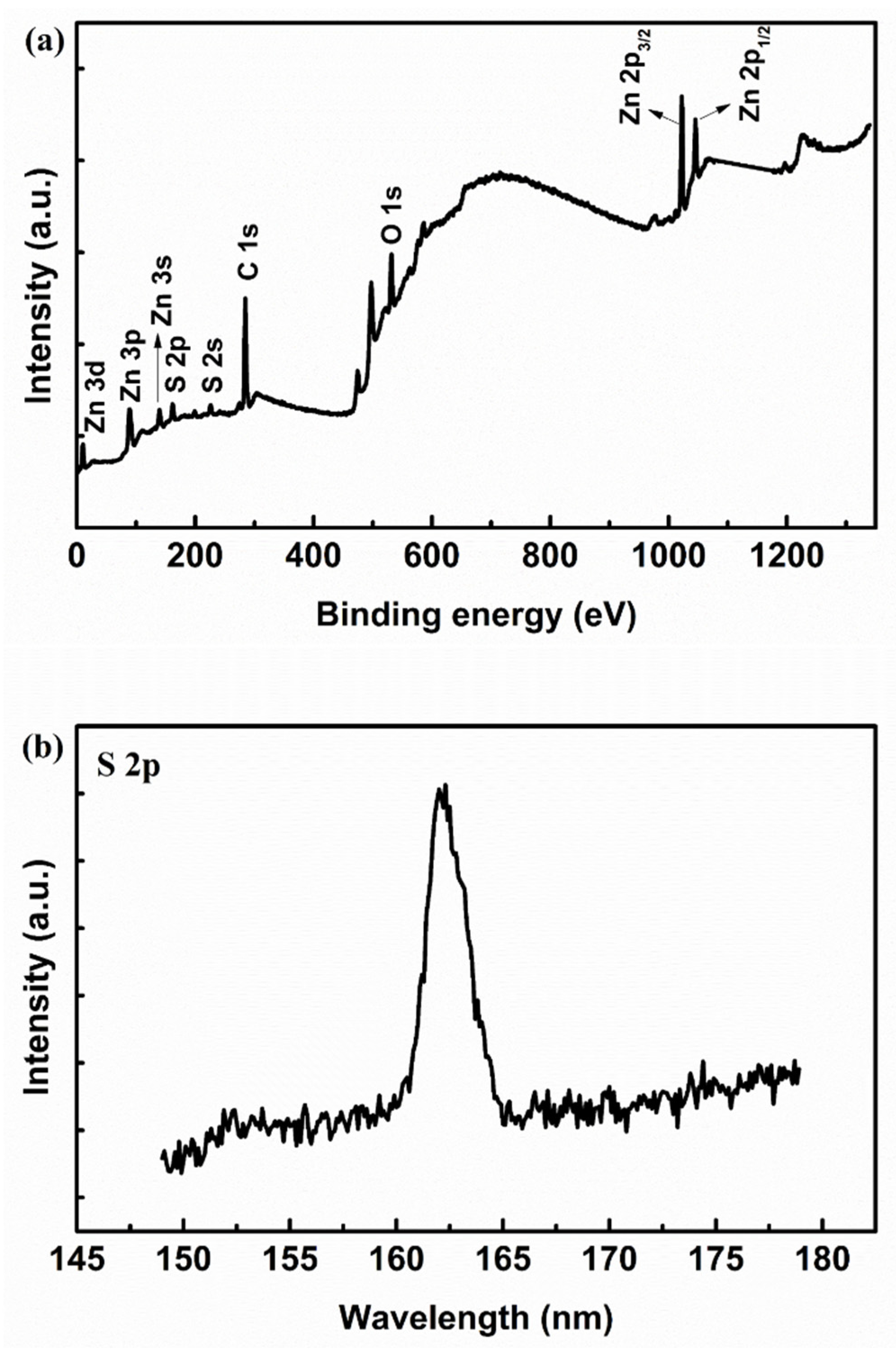

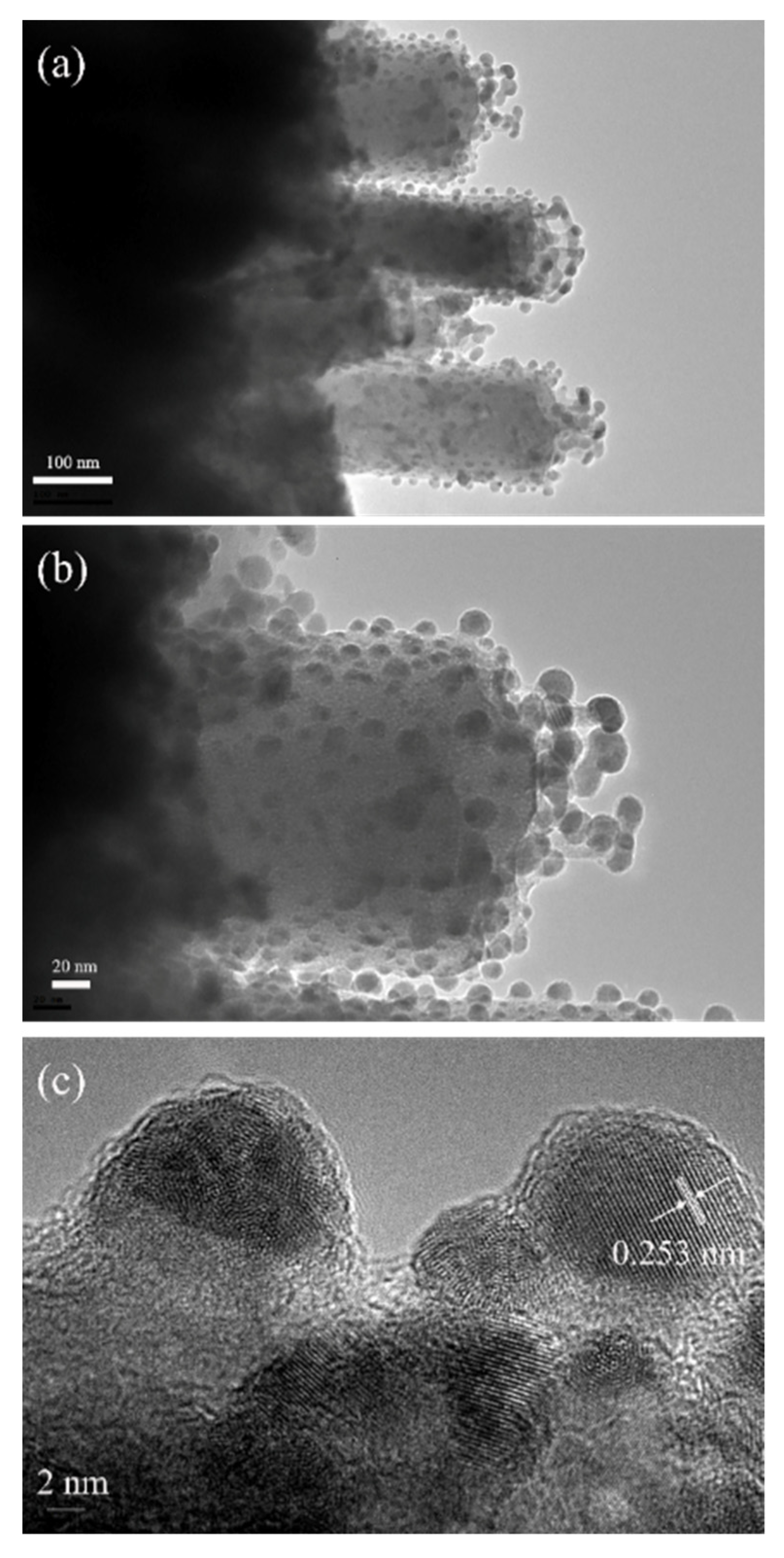
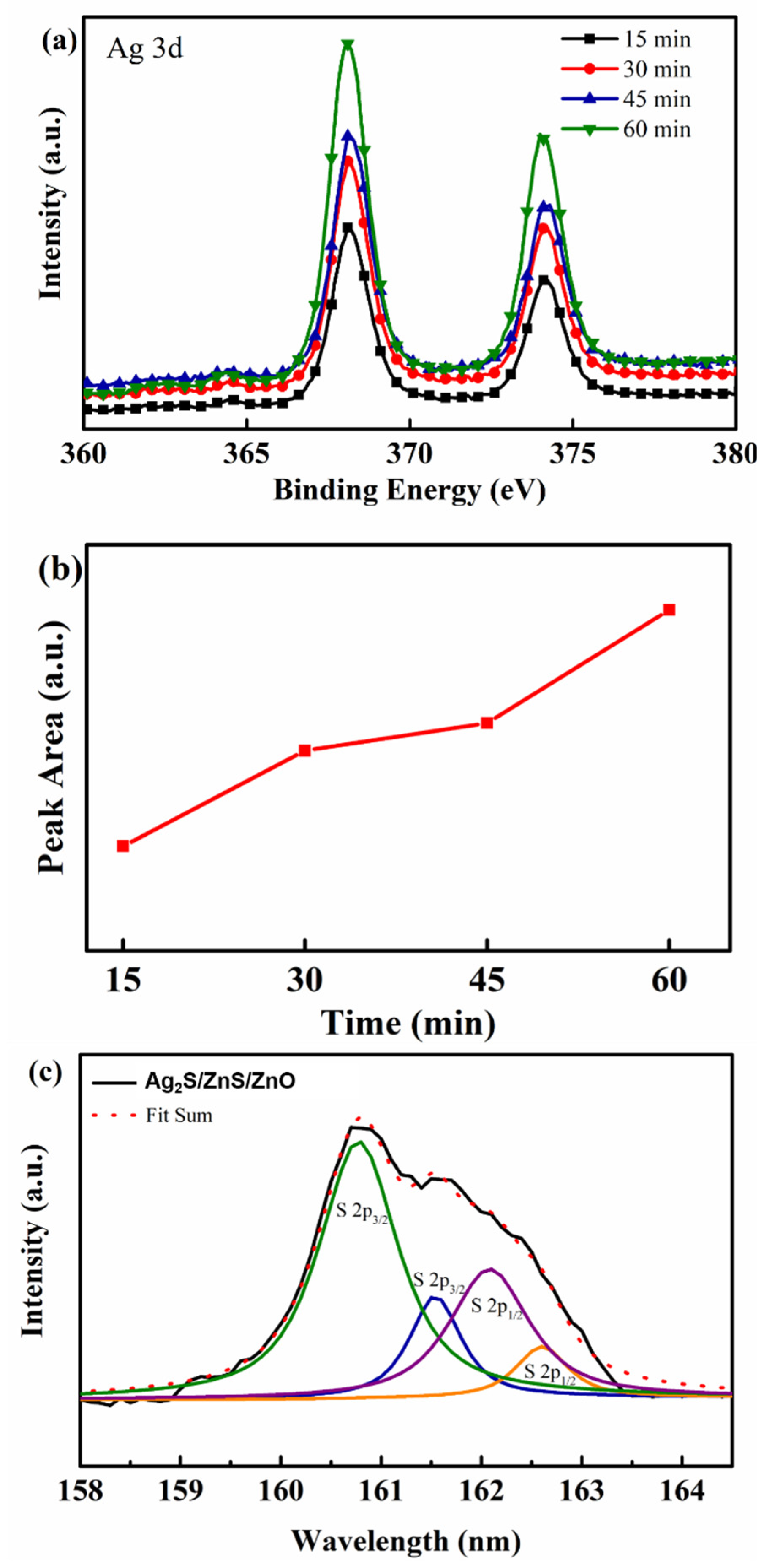
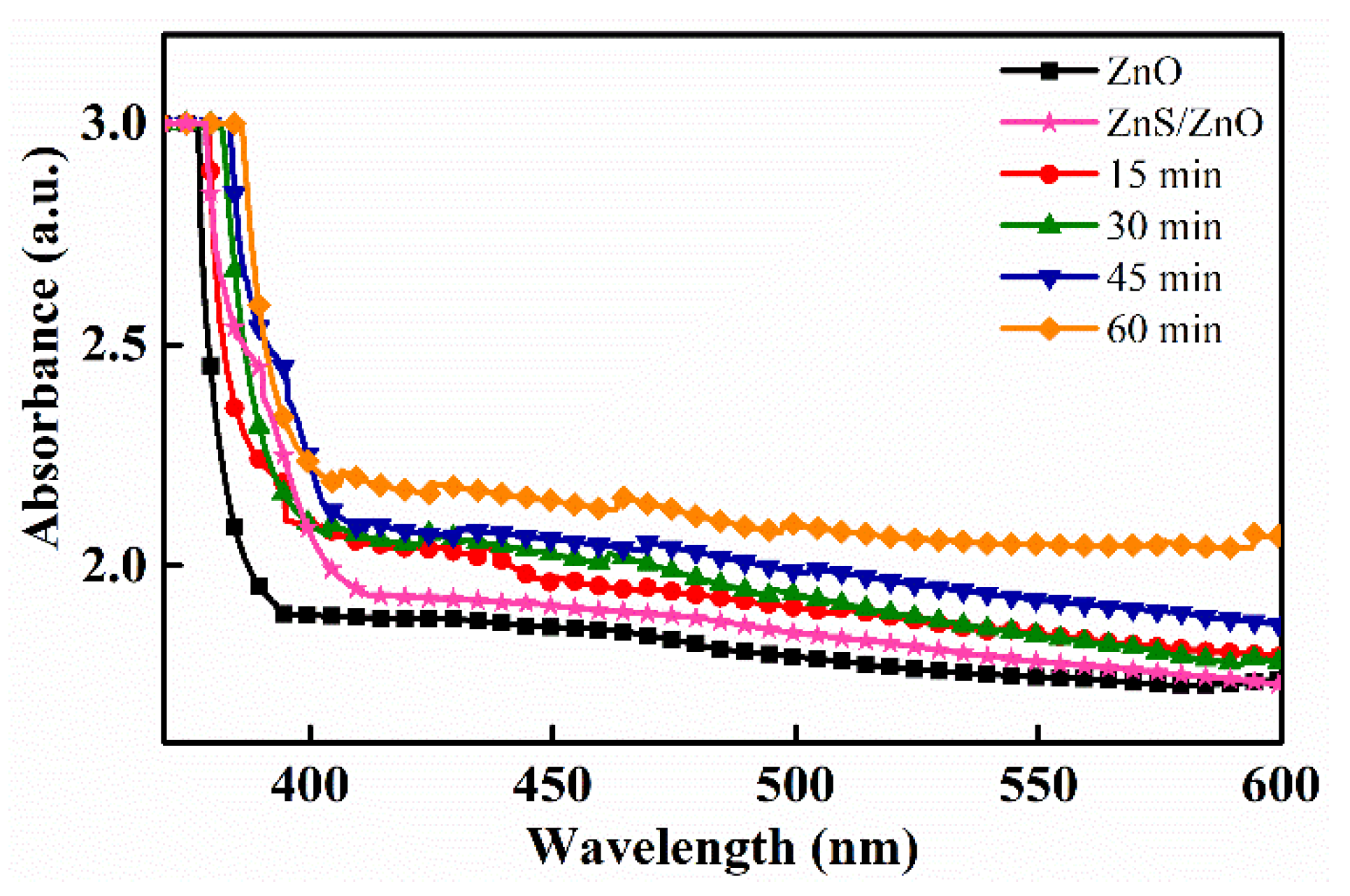
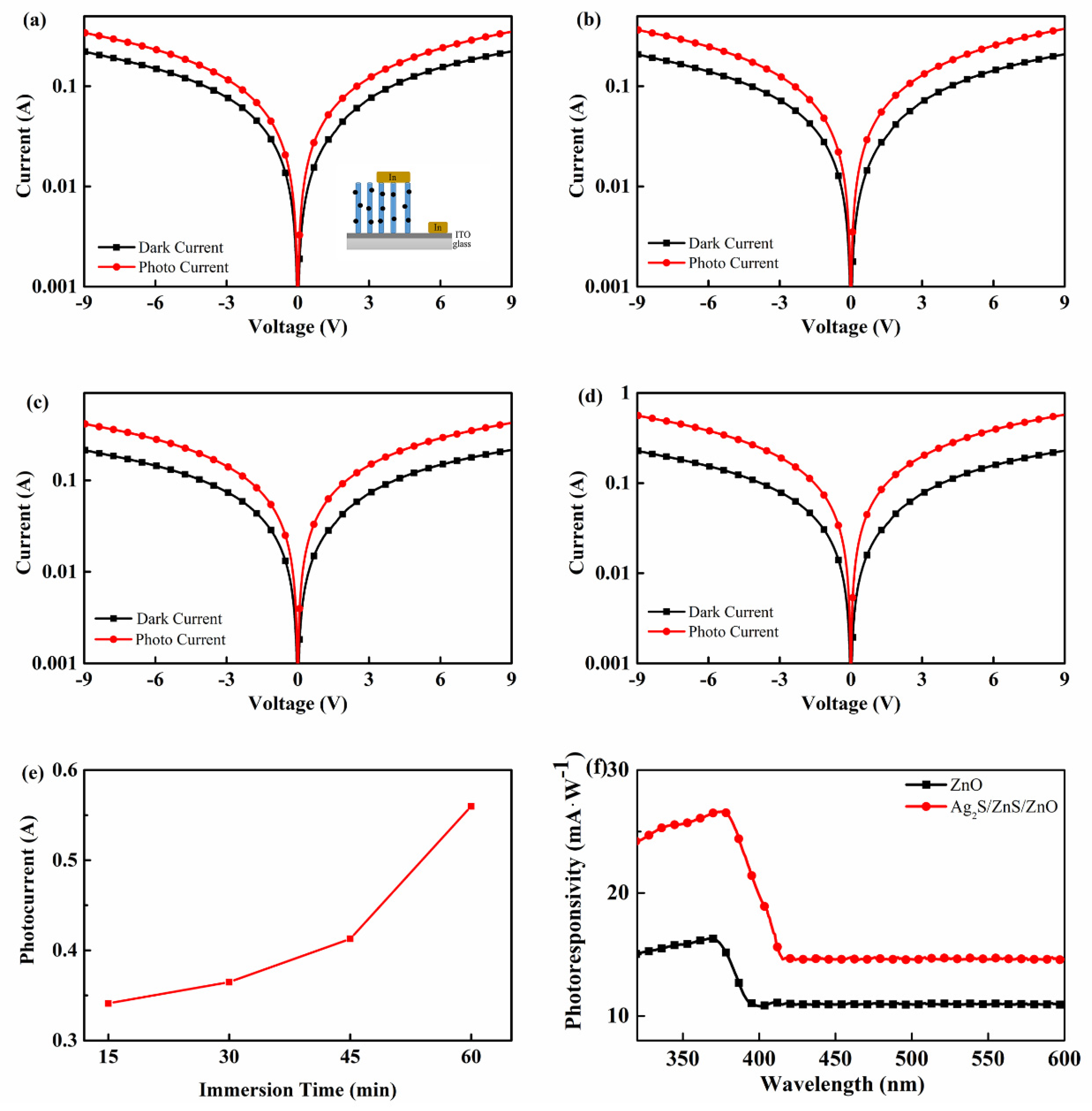
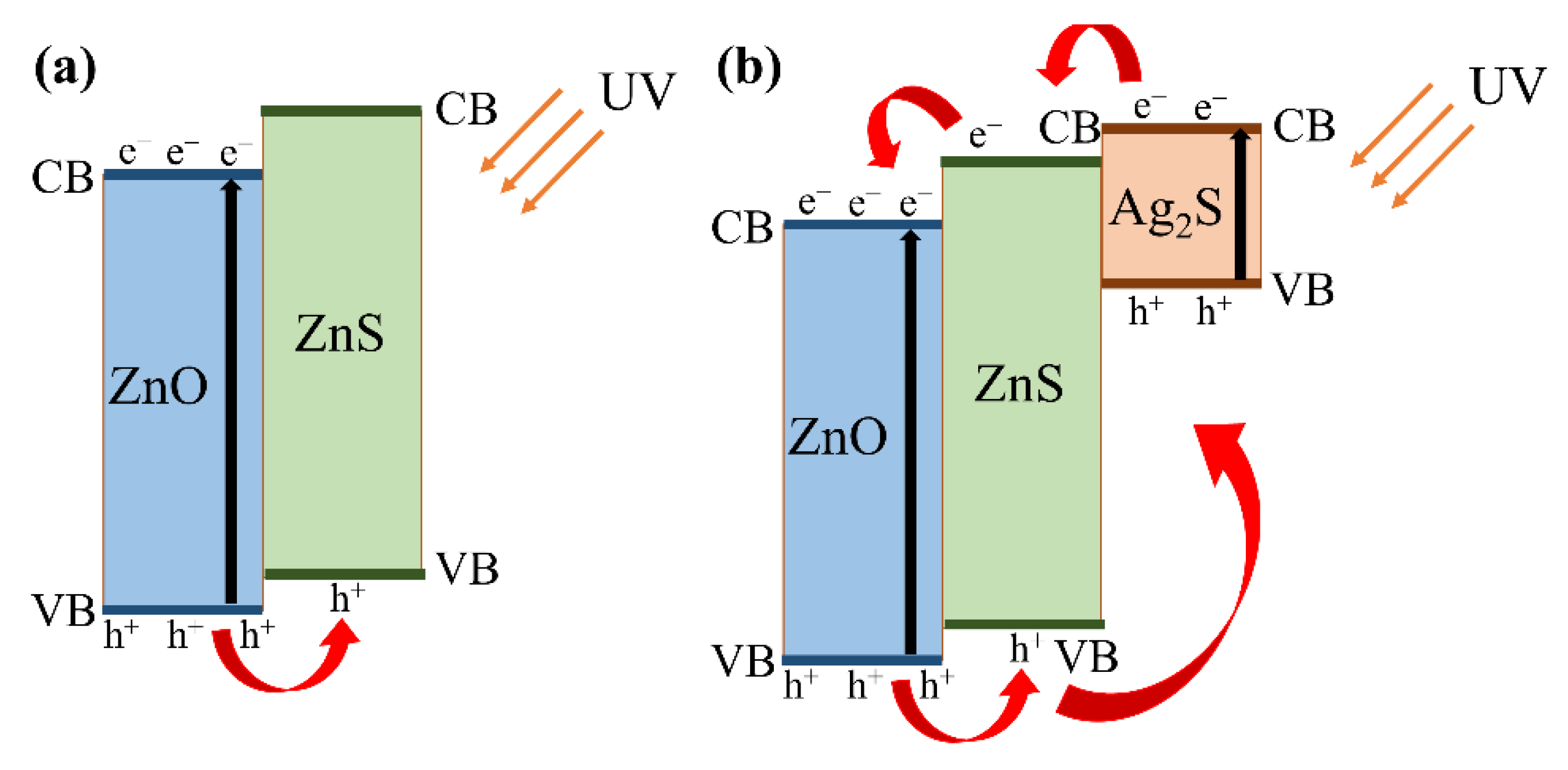
Publisher’s Note: MDPI stays neutral with regard to jurisdictional claims in published maps and institutional affiliations. |
© 2021 by the authors. Licensee MDPI, Basel, Switzerland. This article is an open access article distributed under the terms and conditions of the Creative Commons Attribution (CC BY) license (http://creativecommons.org/licenses/by/4.0/).
Share and Cite
Jin, Y.; Jiao, S.; Wang, D.; Gao, S.; Wang, J. Enhanced UV Photoresponsivity of ZnO Nanorods Decorated with Ag2S/ZnS Nanoparticles by Successive Ionic Layer Adsorption and Reaction Method. Nanomaterials 2021, 11, 461. https://doi.org/10.3390/nano11020461
Jin Y, Jiao S, Wang D, Gao S, Wang J. Enhanced UV Photoresponsivity of ZnO Nanorods Decorated with Ag2S/ZnS Nanoparticles by Successive Ionic Layer Adsorption and Reaction Method. Nanomaterials. 2021; 11(2):461. https://doi.org/10.3390/nano11020461
Chicago/Turabian StyleJin, Yimin, Shujie Jiao, Dongbo Wang, Shiyong Gao, and Jinzhong Wang. 2021. "Enhanced UV Photoresponsivity of ZnO Nanorods Decorated with Ag2S/ZnS Nanoparticles by Successive Ionic Layer Adsorption and Reaction Method" Nanomaterials 11, no. 2: 461. https://doi.org/10.3390/nano11020461
APA StyleJin, Y., Jiao, S., Wang, D., Gao, S., & Wang, J. (2021). Enhanced UV Photoresponsivity of ZnO Nanorods Decorated with Ag2S/ZnS Nanoparticles by Successive Ionic Layer Adsorption and Reaction Method. Nanomaterials, 11(2), 461. https://doi.org/10.3390/nano11020461







